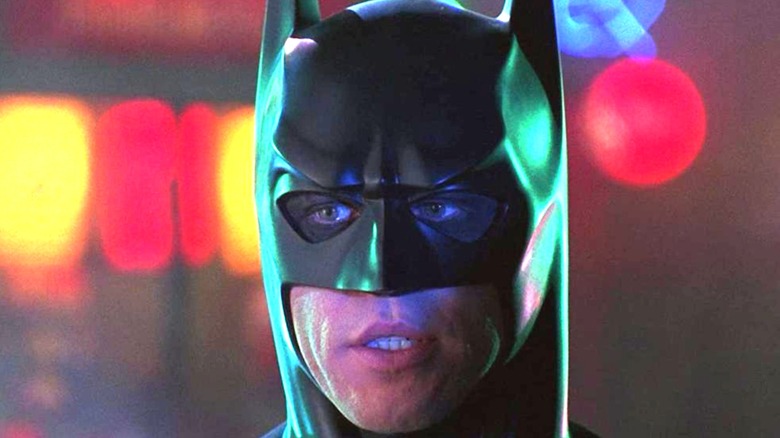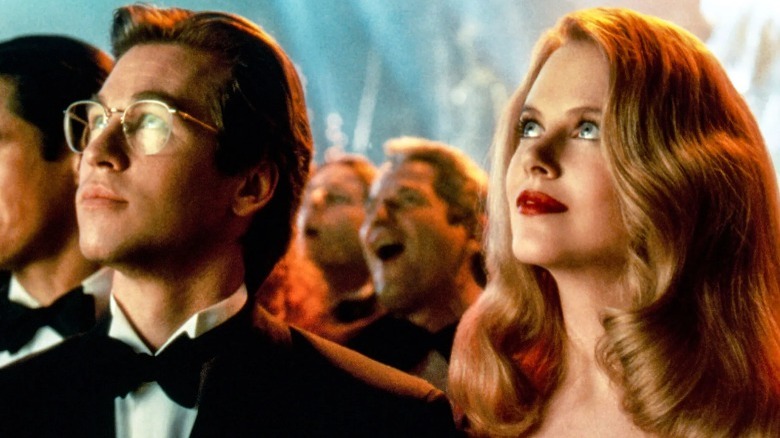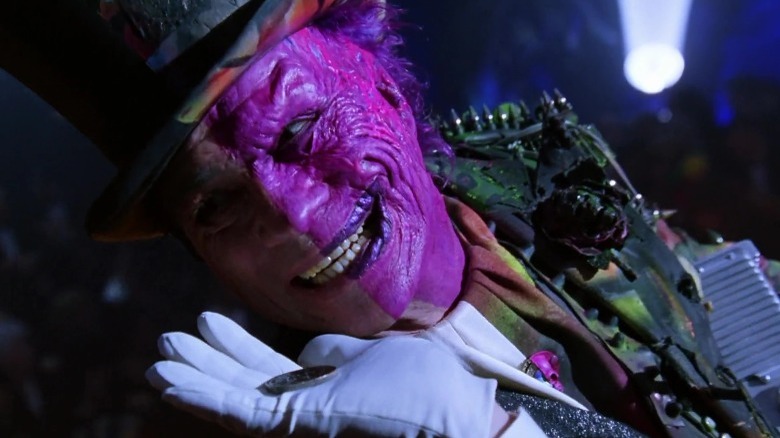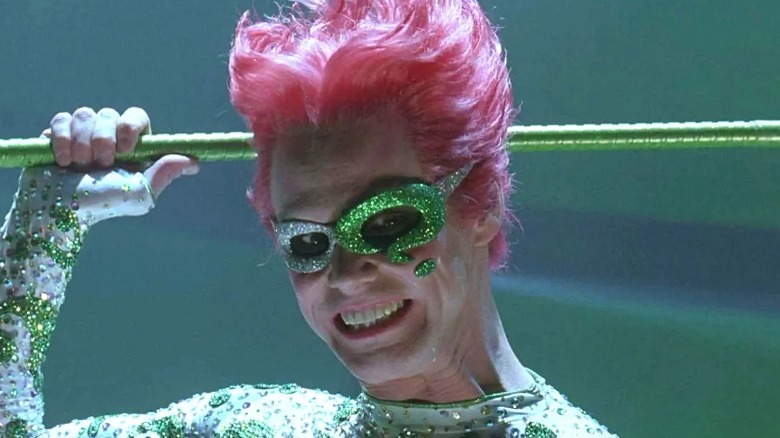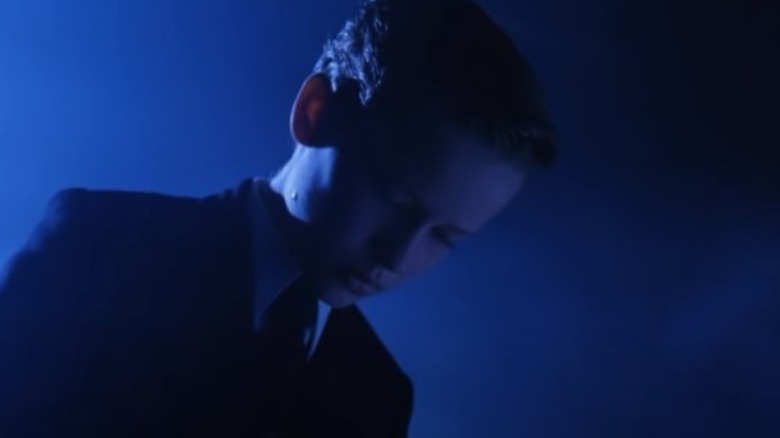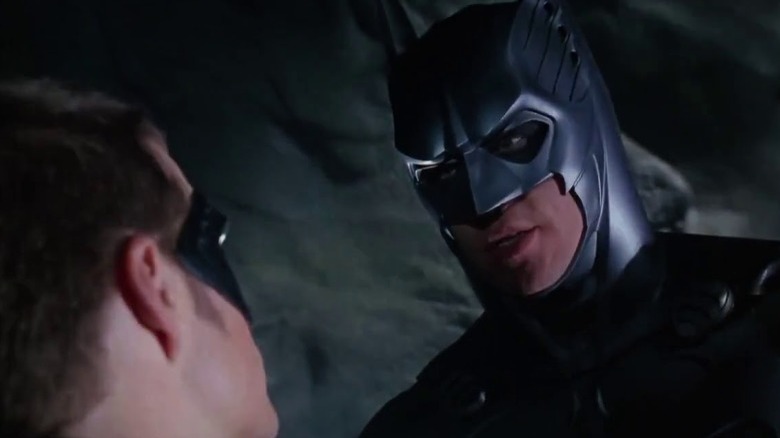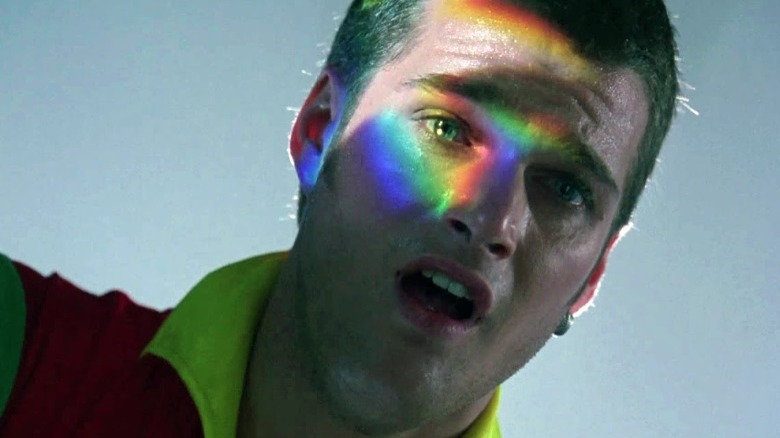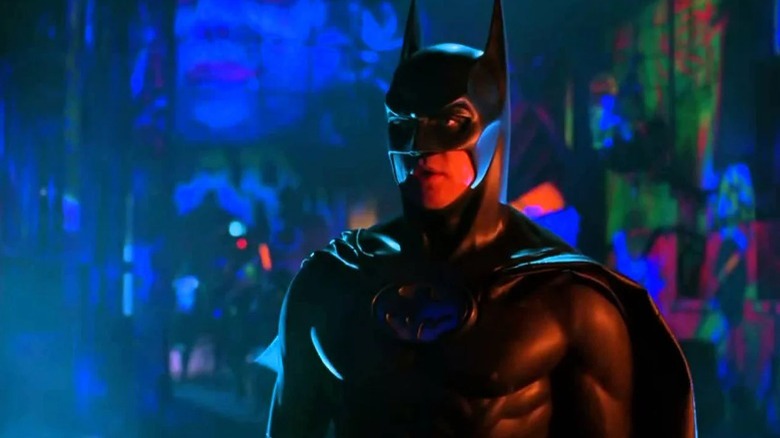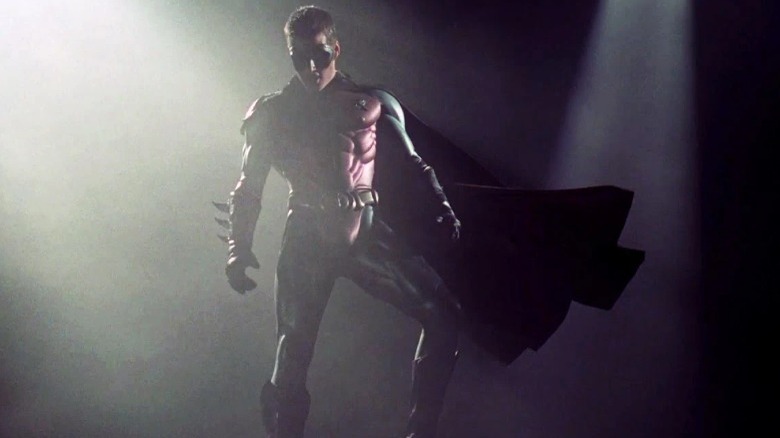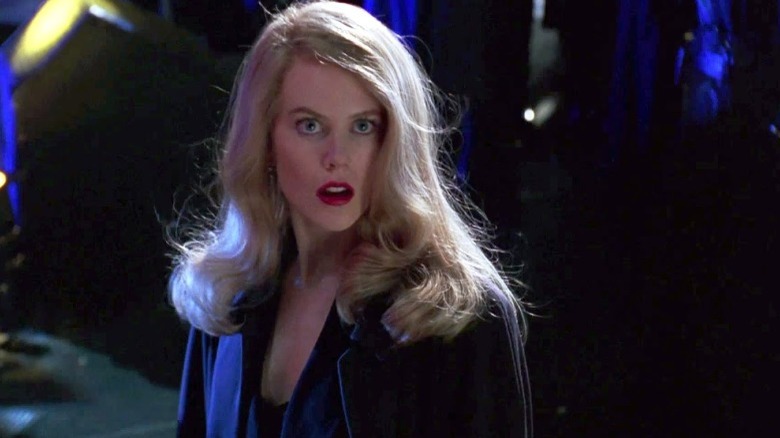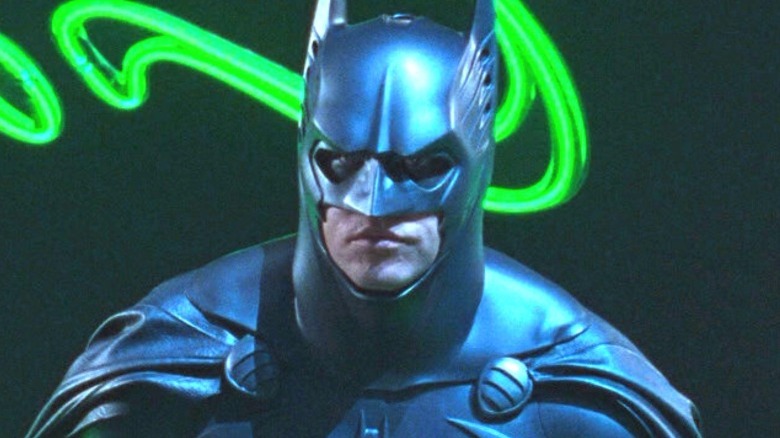The Ending Of Batman Forever Explained
Nothing strikes fear in the hearts of criminals like tight rubber and a masked gaze that would put Derek Zoolander to shame on the runway. On the runway, they'd call it "The Smoldering Bat." Too on the nose? Regardless, Val Kilmer portrays a Batman who is uniquely designed to cause villains to do a quick double-take instead of truly shrieking in fear. The Joel Schumacher-directed "Batman Forever" is a product of the '90s, and it is there that it will remain. It's a time capsule of sorts, where camp and buffoonery meet grit and sexual tension in an often awkward pairing that will share neither the timelessness of Tim Burton's "Batman" nor the evolved and provocatively complex magnetism of Matt Reeves' "The Batman." Still, "Forever" will always remain a part of the Dark Knight's on-screen legacy for better or worse.
"Batman Forever" didn't crash land like its successor, "Batman & Robin." In fact, it was a massive box office smash that surprised audiences with its slick pop sensibility after many were put off by the grim psychosexual grotesquery of Burton's "Batman Returns" (via The Hollywood Reporter). With "Forever," Schumacher and company created a world of cartoonish delights like beach ball-sized bombs, mind-sucking lasers, and Two-Face's ridiculous split-image lair. Meanwhile, the movie attempts to deal with the psyche behind a man who dresses as a bat to protect his city, commenting on the penchant for many to equate tragedy with destiny.
Has it aged well? That's up to each individual fan's patience for its mid-'90s virtues. But underneath all the cringe-inducing dialogue, zany Jim Carrey one-liners, and the strange air of eroticism permeating the film, there's a discussion regarding true emotional turmoil and how one actually copes. Let's dive into the more fascinating elements of the narrative behind "Batman Forever."
The psyche of a man dressed like a flying rodent
Despite their stylistic and tonal differences, there is a bridge from the previous two Burton films to Schumacher's Gotham, albeit a very shaky one. While some might debate whether "Forever" is a true sequel to "Batman Returns," the proof is in the pudding. Conversational cues allude to Batman's experience with vengeance not being quenched by the death of the Joker. Additionally, Nicole Kidman's Dr. Chase Meridian makes a reference to Michelle Pfeiffer's Catwoman when she asks, "Or do I need skintight vinyl and a whip?" Last but not least, Michael Gough and Pat Hingle return as Alfred and Commissioner Gordon, respectively. Of course, Billy Dee Williams doesn't play Harvey Dent aka Two-Face in this world, despite having played the role in the '89 film.
All of this is important to keep in mind when exploring Bruce Wayne's state of mind as the story begins. When Dr. Meridian arrives at the scene of a Two-Face crime, she appears to instantly begin analyzing Batman, stating, "I could write a hell of a paper on a grown man who dresses like a flying rodent." Batman defensively retorts that bats aren't rodents. Right out the gate, this film does pose this underlying question that might only partially be answered in the third act. Why, exactly, does Bruce Wayne dress as a bat? There are plenty of other ways a vigilante could choose to portray himself. Throughout the legacy of Batman as a character, it's often suggested that he is, perhaps, as mentally ill as those he combats — his fixation has simply taken a far less destructive turn.
The tale of Two-Face
Two-Face is an iconic Batman foe, and fans of the Caped Crusader know his background all too well. Of course, like most decades-old comic book characters, the details can vary depending on which story you read (or watch). One thing that is certain is that Two-Face was once Gotham's premiere District Attorney, Harvey Dent. He was vicious in the court room and would pursue criminals relentlessly. The comic story "Batman: The Long Halloween" by writer Jeph Loeb and artist Tim Sale finds Dent going after the mob. While in court, mobster Sal Maroni agrees to testify against boss Carmine Falcone. However, Maroni splashes Harvey with acid in the face, claiming the DA to be the "Holiday Killer" that the mob feared at the time. There's also the big-screen take in Christopher Nolan's "The Dark Knight," in which Harvey's face was burned in an explosion caused by the Joker.
"Batman Forever" doesn't focus so much on Dent's pre-Two-Face career, only providing a scant few details. In the film's opening sequence, Two-Face attempts to dump a safe full of acid on the population below, having also trapped Batman inside with the chemicals. Two-Face then proclaims to the crowd, "We're serving the very same acid that made us the men we are today!"
Later in the film, a TV news piece shows file footage of Harvey Dent's disfigurement at the hands of Sal Maroni in court years earlier. In a rather odd storytelling choice, Batman was apparently sitting in on the trial and lunged to protect Harvey, but failed. The report continues to share that as a result of Harvey's brain damage from the incident, he blames Batman. While there are several things that remain narratively shaky with this depiction of events, it at least offers enough detail to show us where Two-Face comes from in Schumacher's world.
Hell hath no fury like a mad scientist scorned
At the height of his mid-'90s fame, the inimitable Jim Carrey donned the question-marked bowler hat (among many other flamboyant accessories) to become Schumacher's Riddler. Edward Nygma is a man singular of mind, focused entirely on his own whims and flights of fancy -– morals be damned. Often, Nygma has some sort of rationale for his villainy. In "Forever," he's simply a mad scientist whose aspirations were squashed by billionaire Bruce Wayne. But let's be honest — it's not like Bruce was being unreasonable. After all, Nygma literally pitched a technology that could manipulate people's brainwaves. Sure, we know that in reality controlling minds through brain wave manipulation is a goofy plot and completely made up. But in the cartoony world of Schumacher's Gotham, this technology is akin to creating a potential superweapon of mass manipulation. Understanding that possible future, Bruce slaps a firm "no" on his support for the project.
Angered, Nygma does everything he can to show Bruce Wayne what he's capable of. He starts with murdering his boss by tossing him out of the research tower -– a move that hearkens back to Max Schreck's murder attempt of Selina Kyle in "Batman Returns." Bad guys must love tossing people out of buildings in Gotham. The Riddler's motives aren't multi-layered, secretive, or emotionally-charged like Paul Dano's incarnation of the villain in "The Batman." No, Carrey's Riddler simply wants to spite Bruce Wayne, and subsequently Batman. That's really all there is to it. But hey, at least this Riddler wins the award for the most vibrant onesies ever worn by a dangerous mastermind.
The crucible of tragedy
Sadly, the villains in "Forever" are disappointingly one-note. The most depth any viewer might hope to obtain is through the narrative surrounding Bruce Wayne's past and his partnership with Dick Grayson. We know the story — it's as iconic as Batman himself. There's a shady crook holding the Wayne family at gunpoint, falling pearls bouncing off the pavement, the image of Thomas and Martha Wayne lying motionless under a lone street light –- you get the point. Out of this tragedy, Batman is born. Some might see Batman as Bruce's version of vengeance, with a hard line against killing. After all, that's what 2022's "The Batman" depicts. The Bruce Wayne of "Batman Forever" warns Dick against the notion of killing out of vengeance. If Dick kills Two-Face, Bruce tells the future Boy Wonder, he'd be alone just like him, alluding to some guilt Bruce may be harboring over the Joker's death or his whole crusade in general.
Batman's fixation is that he seeks to prevent death and destruction. He doesn't want anyone else to suffer the pain that he has. In realizing that Dick Grayson is going through the same turmoil after losing his family, Bruce utters to Alfred, "I killed them." He then corrects himself, saying, "He [Two-Face] killed them." But Alfred repeats Bruce's initial line back to him, suggesting that Bruce feels a sense of ownership over the Graysons' deaths. The film positions it as a Freudian slip — we all know that Bruce is feeling like a failure in that moment. Because he couldn't save the Graysons, their demise is for Batman to own. It's a hefty burden, and one that would be unbearable in a city rife with crime.
Birds of a feather
Bruce Wayne sees his younger self in Dick Grayson. Both lost their parents in unimaginable tragedies, and not through mere accidents — their families were taken from them by malicious actors. The shared moment of being orphaned is pivotal for both of these characters, ultimately defining who they become for the rest of their lives. In most versions of the Batman mythos, Dick is a young child when he loses his parents, but Chris O'Donnell's take on the character in "Batman Forever" is an adult. Therefore, Dick is not Bruce's ward or adoptive son — Bruce is merely a wealthy aristocrat who offers room and board to a young man who is grieving.
This narrative change might be one of the few elements of "Batman Forever" that fans could consider an improvement. After all, a man who is supposedly a hero thrusting a young boy into danger, even in the name of guidance and mentorship, is definitely something that only fits in a comic book. The film, however, goes to great lengths to show us that Bruce understands Dick's pain and that they truly are the same in so many ways. The film also alludes to the idea that Bruce was once stricken with a thirst for vengeance. He seemingly talks from experience when explaining to Dick where that road leads. It's easy to imagine that Bruce is specifically referring to the role he played in the Joker's death in Burton's original film, given that the '89 movie made the Joker the murderer of Thomas and Martha Wayne.
The void of revenge
The lesson at the core of the film is pretty simple: don't be consumed with hatred and thoughts of vindication. Two-Face causes the deaths of Dick Grayson's acrobatic family after threatening the entire circus. Rightfully, Dick is angry and he wants nothing more than to see Two-Face buried six feet under. In fact, Dick is so forthright about his new mission that he tells Bruce Wayne right out of the gate that he doesn't wish to stay with him — he simply wants to find and kill Two-Face.
The problem is that revenge is really just instantaneous gratification. Ultimately, what happens when that gratification subsides? Dick will still be left with the memories and pain of losing his family. In reality, there's nothing that can ever ease the emotional struggle of losing someone near and dear. Time only makes the pain easier to bear. Bruce is well-versed in this world, having lost his parents at a young age. Whether or not you don't consider the Tim Burton films as canon within the "Forever" storyline, Bruce isn't exactly subtle about his experience with vengeance — even if it's as simple as pummeling baddies on the streets at night. It's a fruitless pursuit that leads nowhere. The best way to move forward is to engage in a purpose that is gratifying. Dick finds that avenue in his role as Robin.
The greatest riddle to ever be solved
In Gotham, there is one mystery that supersedes all: Who is the Batman? We, the viewers, know exactly who Batman is. We've always known. But we also know what it means for Batman's identity to be uncovered. As a vigilante, he'd now be held accountable for his actions by authorities, many of whom are corrupt. Even if Commissioner Gordon sees Batman as an ally, once Bruce's identity is revealed Gordon would have no choice but to arrest him in order to maintain order, and Bruce's entire crusade would be over.
While the most obvious person in the entire movie to uncover his identity might've been Dr. Chase Meridian — a woman who is close to both Bruce Wayne and Batman and is a psychologist — the Riddler is the one to unveil the secret. With most incarnations of the Riddler, this would make sense, given that he fancies himself a superior being with supreme intellect. But the Riddler in "Batman Forever" doesn't exactly put the pieces together with his own cleverness. He simply reads Bruce's mind with his strange brain wave machine and sees an image of a bat.
Look, the strength of this film is not necessarily the sound logic of its script, but it does often embrace its comic book origins by indulging in the fantastical. Of course, one of two things must occur — either Batman's career comes to an end with this film, or the villains have to die or have their mental capacity compromised. Two-Face bites the dust and the Riddler is deemed insane, eliminating his credibility. Thus, Batman can suit up to fight another day.
Holy rusted metal, Batman!
The release of "Batman Forever" in 1995 marked the first time Robin had appeared in live action since the days of Adam West and Burt Ward in the seminal '60s TV series, known for giving the Dark Knight a not-so-dark crusade. Everything was much goofier and completely campy. (Shark repellant, anyone?) Still, that didn't stop the filmmakers from plugging an obvious nod to the days of yore in "Forever." When Batman and Robin make their way into the Riddler's base, Robin exclaims, "Holy rusted metal, Batman!" Indeed, he's identifying sheets of rusted metal with holes in them. But it's a callback to Ward's incarnation of the character, who'd make similar over-the-top exclamations that weren't quite as literal.
While totally out of place, this line truly solidifies the partnership that Batman and Robin have engaged in as they set out to bring down Two-Face and the Riddler. There could be no doubt to a '90s audience that if there were to be a sequel to this film, it'd feature the duo once again. Of course, we know that came in the form of 1997's "Batman & Robin." The Dynamic Duo is an iconic pairing in the world of superheroes. And make no mistake, Robin is possibly the most iconic sidekick in superhero history (although Kato from "The Green Hornet" might be a close second).
A proto-Harley Quinn?
We all know the '90s run of Batman films ended with, as Arnold proclaimed, "The Ice Age!" But there was always potential for more down the line if things worked out a bit differently from a financial and critical perspective — there were plenty of canceled Batman movies in and out of development before Christopher Nolan came along. Batman fans likely took note of one character who is technically original to the film: Dr. Chase Meridian. From a certain angle, she entertains several parallels with another popular DC character, Harley Quinn. While she never takes a turn for the villainous, the potential is always there.
You're probably wondering, how so? Well, let's look at the obvious. She's a blonde psychologist with a completely destructive attraction to all the wrong men (she even says so herself). Dr. Meridian becomes so infatuated with a man in a bat costume that she doesn't even care who is underneath it all. Dr. Harleen Quinzel is also a blonde psychologist who works with patients in Arkham Asylum. She eventually develops an unhealthy attraction to the Joker and springs him out of the joint. After her turn to villainy, she adopts the moniker of Harley Quinn.
Harley was introduced in "Batman: The Animated Series" in 1992, and quickly became a breakout character. If we've learned anything about her in recent years, it's that she doesn't need the Joker — she stands out as an incredibly popular character (even a heroic one, sometimes) all on her own. Chase Meridian's function in "Batman Forever" is as a love interest and complicating factor in Bruce's psychological journey — but who's to say she couldn't have had a future as a villain?
Destiny is a matter of choice
Batman is a calling that will engulf Bruce Wayne's entire life. But the real question is, why would anyone willingly safeguard the streets of Gotham when it means so constantly putting oneself in danger? Is Batman compelled to do so? For a time, he seems to think so. Bruce tells Dick that being Batman's partner is not the life he'd want. He tries to dissuade the young man by telling him, "You still have a choice." This implies that Bruce doesn't have a choice in what does. Mentally, he's compelled to go out night after night and combat the criminal element as if it's his destiny. But after Dr. Chase Meridian refers to the mantle of Batman as a curse and Bruce finds himself falling for her, he does attempt to make a choice. He tells Dick that he's giving it all up. No more Batman.
Of course, we know how this goes. The Riddler won't let his squabble with Bruce Wayne and Batman go. He breaks into Wayne Manor before Bruce can confess to Dr. Meridian and the Riddler captures her, leaving Bruce unconscious on the floor. When Batman ultimately saves the day, he tells the Riddler that he is both Batman and Bruce Wayne not because he's compelled to be, but — now — because he chooses to be. The addition of the word "now" implies that his crusade was thrust upon him against his will up until this point. More modern incarnations of the character, such as Nolan's version, have highlighted how Batman is actually the man's real identity, and Bruce Wayne is the mask. Maybe that was once the case for Kilmer's Batman, until the ending of "Batman Forever" finds him more self-aware, secure, and at peace.
